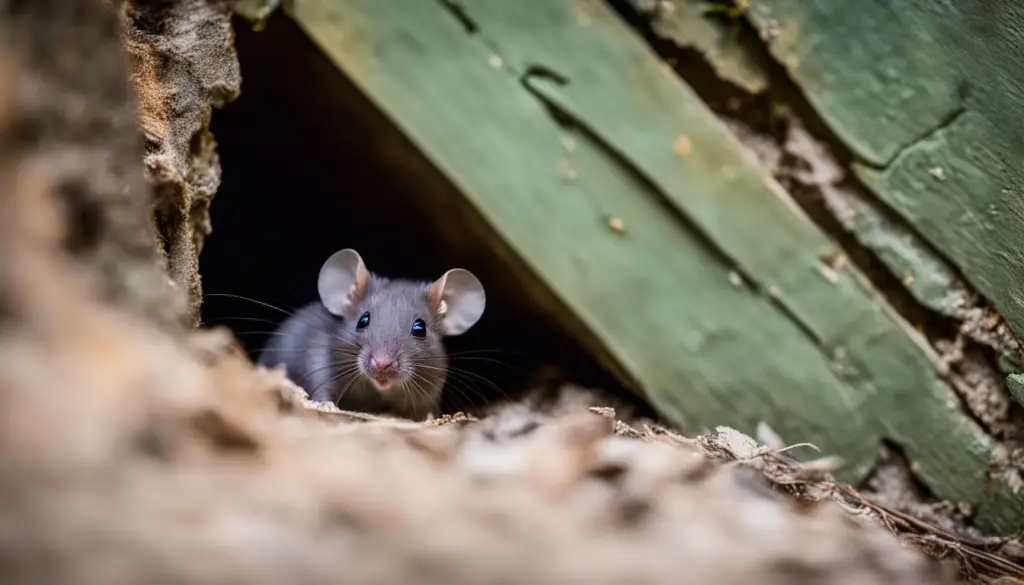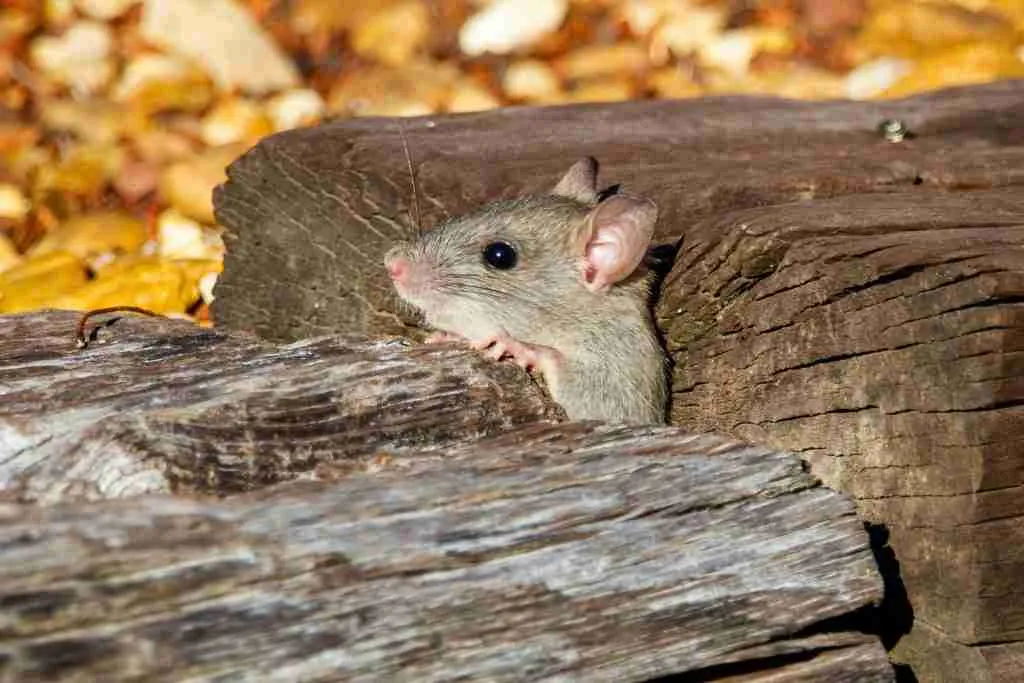Ever noticed yellowish-brown marks around your home and wondered what they are? These mysterious stains could be mouse urine – a sure sign of rodent infestation. This article will guide you on identifying such stains, distinguishing them from others, and safely cleaning them up to maintain a healthy environment at home.
Stick with us as we uncover the hidden signs of mice living right under your nose!
Contents
ToggleKey Takeaways
- Mouse urine stains can be identified by their yellowish-brown discoloration, irregular shapes, dampness, and musky odor.
- Look for small black droppings and yellowish-brown spots on surfaces to identify mouse infestation.
- Unusual noises in walls, chew marks on surfaces, and changes in pet behavior are signs of mice living in your home.
- To clean these urine stains, remove solid debris first, apply a cleaning solution of water and white vinegar or bleach diluted with warm water, rinse the area thoroughly with clean water, and allow it to air dry completely.
Identifying Mouse Infestation Signs

Look out for droppings and urine, unusual noises in walls, chew marks on surfaces, and changes in pet behavior.
Presence of droppings and urine
Mice leave things behind. Look for small, black droppings. They look like tiny seeds. These are a clue that mice live in your house. Also, urine is another sign of these small invaders. It leaves yellowish-brown spots on surfaces and smells bad, almost like strong ammonia.
The more it stinks, the more mice you have! For more on stain removal, check out how to remove black urine stains.
Unusual noises in walls, ceilings, or floors
Mice make noises. They live in the walls, ceiling, or floors of your house. Scratch sounds tell you that mice move around in these areas at night. You may hear gnawing sounds too. They are busy creatures when it is dark and quiet! These noises not only disturb sleep but also mean bigger mouse problems like stains from their pee.
Gnaw or chew marks on walls, floors, and wiring
Mice have sharp teeth that they use to gnaw on things. They leave chew marks behind as they work away at walls, floors, and wiring. These marks can be rough and uneven. This gnawing can harm your house.
It can make cracks in the walls or damage cords and cables. Damaged wires are bad because they could start a fire or break an appliance. Chewed-up wires need fixing fast for safety reasons.
Unusual pet behavior
Dogs and cats have keen senses. They can act weird if they smell mice in your house. Your dog might bark at walls or start to dig at the floor. You may see your cat trying to catch something that you don’t see.
Look out for these signs because it could mean mice are hiding somewhere around your home!
How Mouse Urine Stains Look

Urine stains can be identified by their yellowish-brown discoloration, irregular shapes, dampness, and musky odor. Learn more about these distinctive characteristics and how to distinguish them from other stains.
Yellowish-brown discoloration
They can appear as yellowish-brown discoloration on surfaces, even, such as ceilings. Stains may be more noticeable on lighter-colored walls. They can have irregular shapes and uneven outlines, making them stand out from other types of stains.
Remember that urine is highly acidic, which can cause dampness in the material. As a result, you might feel a soft or spongy texture around the stain area.
Irregular shapes
Mouse’s urine often has irregular shapes. They may appear as thin lines, dots, drops, or streaks on vertical surfaces. These stains can have an uneven outline and may even show tail drag marks through the deposit.
So if you notice any unusual markings that don’t look like regular spills or splatters, it could be a sign of urine stains. It’s important to be vigilant in identifying these irregular shapes as they can help indicate a potential infestation in your home.
Dampness
These stains can sometimes cause dampness in the affected area. When urine seeps into materials like ceilings, it can lead to a soft or spongy texture forming around the stain.
This dampness is a result of the moisture content in the urine and can be an indicator of an infestation. So, if you notice any yellowish-brown stains accompanied by dampness, it’s important to address the issue promptly to prevent further damage and potential health risks associated with mice.
Musky odor
A musky odor is a strong and unpleasant smell that can indicate the presence of urine stains. This odor is often described as being similar to ammonia. Even after the urine stain has dried, the musky odor may linger in the area.
If you notice this smell in your home, it could be a sign of an infestation or the entry of mice into your property. Don’t ignore this odor as urine smell indicate a serious problem that needs to be addressed promptly.
Differentiating Mouse Urine Marks from Other Types of Stains

To distinguish these small creatures’ urine stains from other stains, compare them with other animal urine stains and differentiate them from roof or chimney leaks.
Contrasting with Urine Stains from Different Animals
Mouse stains can be distinguished from other animal urine stains by their appearance. Unlike some animals, mouse pee stains look like thin lines of dots, drops, or streaks on vertical surfaces.
These stains may also have tail drag marks through the fluorescing deposit, making them easier to identify under UV light. Additionally, looking for them pay attention to an irregular shape and an uneven outline, which sets them apart from other types of animal urine stains.
If you have pets, you might also be interested in how to clean dog diarrhea from carpet.
Differentiating from roof or chimney leaks
You should be able to distinguish whether these stains come from roof or chimney leaks looking at their appearance and location. Unlike roof or chimney leaks that cause water stains to spread horizontally, stains left by mice appear as thin lines of dots, drops, or streaks running through vertical surfaces.
These stains are often found on walls, corners, and floors in homes infested with rodents. Moreover, while roof or chimney leaks may result in larger and more irregular-shaped water stains on the top of your room, mouse stains are usually yellowish-brown in color and have an uneven outline.
This distinction can help homeowners identify whether they are dealing with a mouse infestation or a structural issue with their roof or chimney.
Removing Urine Marks

To clean urine stains, start by identifying the stained area and removing any solid debris. Then, apply a cleaning solution such as white vinegar or bleach diluted with warm water.
Rinse the area and allow it to air dry completely.
Identification of stained area
To identify these stains, look for thin lines or drops running along walls, floors, or roofs. The stains are yellowish-brown and may have an irregular shape. Sometimes, you can see tail-drag marks through the stain.
If the stained area feels damp or spongy, it could be a cue of mouse pee. Remember to check lighter-colored surfaces as the marks might be more visible there. Make sure to carefully inspect all areas where mice might leave their marks and take note of any discoloration or unusual odors coming from the stained area.
Removal of solid debris
Before you start cleaning a stained area, it’s essential to remove any solid debris first. This will help prevent the stain from spreading and make the cleaning process easier and more effective.
Gently blot the stained area with a clean cloth or paper towel to remove any solid debris. You can also gently scrape or brush off the debris from the surface if needed. Taking this step is essential to effectively get rid of mice and rats urine.
Application of cleaning solution
The next step to take is to make a cleaning solution using water and white vinegar or bleach with warm water. After identifying the stained area, remove solid debris like droppings before applying the cleaning solution.
Let it sit for a few minutes to break down the stain. Then, blot the area with a clean cloth or paper towel to remove any remaining urine and cleaning solution. Rinse with water and allow it to air dry completely.
If the stain is still visible, repeat the process until it’s gone.
Rinse and air-dry
The following step to clean this strong ammonia-like smell nightmare is to rinse and air dry the area.
Firmly rinse urine or droppings thoroughly with clean water.
Finally, allow the area to air dry completely to prevent further spreading of the stain. This method not only helps remove the appearance of old urine but also eliminates its strong and unpleasant odor.
Conclusion
In conclusion, being able to identify these small yellow stains is important in detecting a mouse infestation. Look for yellowish-brown discoloration with irregular shapes and a musky odor.
Remember to clean the stained areas promptly using a cleaning solution of water and white vinegar or bleach to prevent any health issues associated with urine.
FAQs
1. What are the signs of urine stains?
Signs of stains include a strong ammonia-like odor, yellowish residues, distinctive streaking, and dampness..
2. How can we clean these urine stains?
Using rubber gloves, you can clean the pee with commercial cleaner for urine stains or a bleach solution mixed with water. Salt and liquid dish soap also work well. Use the blotting technique and then allow air drying.
3. Are diseases from mouse poop or urine possible?
Yes, mice carry diseases that humans can catch like Hantavirus Pulmonary Syndrome and Salmonellosis. This happens when breathing in air contaminated by uncleaned mouse pee or coming into contact with mouse waste.
4. Where might I find these pests and their signs in my home?
Mice often build nests in cozy spots such as wall voids, false ceilings, refrigerator motor compartments, or amongst garage clutter. They may leave grease rubs along rodent runways or there could be an irregular shape of stain on your roof from mice upstairs.
5. How do I know if it’s really mice causing these issues?
Look for gnaw marks made by mice on large furniture or things kept in unfrequented corners of the home where they like to nest amongst old untouched stuff! You might also smell a musty stale smell which is another sign aside from seeing multiple amounts of sticky pee.
6. Who should I call when dealing with rodent activity?
Setting up traps yourself may help but ideally, professional pest control services should deal with larger infestations due to health risks involved especially if cleaning Mouse droppings off carpet floors.























































